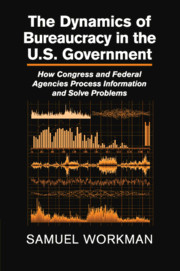 The Dynamics of Bureaucracy in the US Government
The Dynamics of Bureaucracy in the US Government Book contents
- Frontmatter
- Contents
- List of Illustrations
- List of Tables
- Acknowledgments
- 1 Bureaucracy and Problem Solving
- 2 The Dual Dynamics of the Administrative State
- 3 The Regulatory Process as an Attention Mechanism
- 4 Problem Monitoring in the Administrative State
- 5 Problem Prioritization and Demand for Information
- 6 Problem Solving and the Supply of Information
- 7 Information, Bureaucracy, and Government Problem Solving
- Appendix A Conceptualization and Measurement
- Appendix B Statistical Models
- References
- Author Index
- Subject Index
Appendix B - Statistical Models
Published online by Cambridge University Press: 05 May 2015
- Frontmatter
- Contents
- List of Illustrations
- List of Tables
- Acknowledgments
- 1 Bureaucracy and Problem Solving
- 2 The Dual Dynamics of the Administrative State
- 3 The Regulatory Process as an Attention Mechanism
- 4 Problem Monitoring in the Administrative State
- 5 Problem Prioritization and Demand for Information
- 6 Problem Solving and the Supply of Information
- 7 Information, Bureaucracy, and Government Problem Solving
- Appendix A Conceptualization and Measurement
- Appendix B Statistical Models
- References
- Author Index
- Subject Index
Summary
This Appendix contains the full model results for most of the analyses presented in Chapters 5 and 6. Chapter 5 presents what is mostly descriptive inference in gauging the degree to which Congress is able to “tune” the information supply generated by bureaucracy through issue shuffling, issue bundling, and adjusting competition. Chapter 6 assesses the influence of bureaucracy on congressional agendas through problem monitoring, problem definition, and feedback.
B.1 CONGRESSIONAL PROBLEM PRIORITIZATION
The presence of a trend in the data is a key concern in the descriptive analysis presented in Chapter 4. If a time series contains a trend, then breaking the series apart at any point in time will suggest statistical differences in the means of the series over time. Table B.1 contains the results of a Mann-Kendall test for trends in the SNRs of the issue series used in Chapter 5. Of the nineteen issues, a trend in the series is statistically detectable in only six issue series – agriculture, defense, housing, public lands & water, science & technology, and trade.
To examine whether the trends for these issues were problematic in assessing significant differences in the SNRs with regard to party control of Congress, I split these six issues in 1995 when party control switched from predominantly Democratic-controlled Congresses to predominantly Republican-controlled Congresses. I wanted to assess whether significant differences remained after controlling for the trends detected in these issue series. Table B.2 displays a Siegel-Tukey rank sum test with a continuity correction for these six issues.
After taking the first difference of each series, Table B.2 suggests that significant differences associated with party control of Congress remain for all but two of the issues – agriculture and trade. Interestingly, these are two issues that received enormous attention from the president during this period. The USDA was reorganized by the president, and its policy mission was reshaped through bipartisan efforts in Congress. The president also exerted considerable influence in the trade area with the introduction and approval of the North American Free Trade Agreement (NAFTA) during this time.
- Type
- Chapter
- Information
- The Dynamics of Bureaucracy in the US GovernmentHow Congress and Federal Agencies Process Information and Solve Problems, pp. 171 - 178Publisher: Cambridge University PressPrint publication year: 2015
